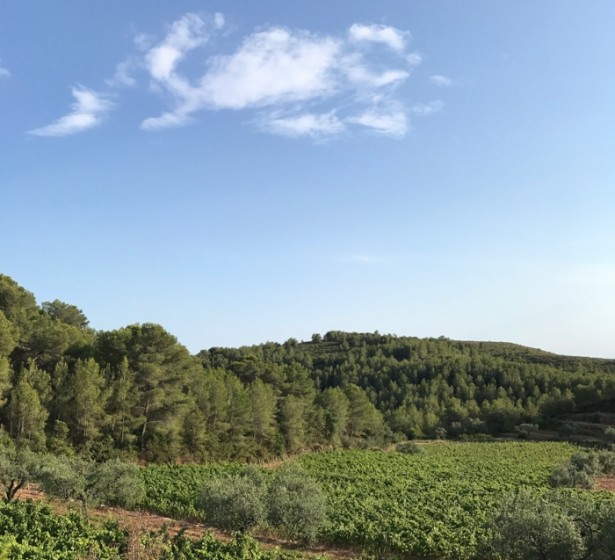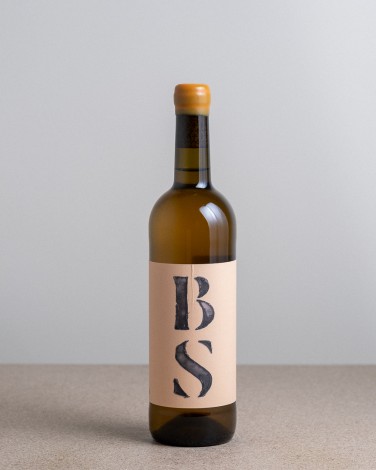The birthplace of BS

Partida Creus. Rings a bell? Maybe not; as much as it should be, that name isn't yet on everyone's radar
If you're a natural wine freak like myself, then you've surely spotted their highly recognizable two-letter label here and there on the counter of your favorite bar or popping like mushrooms on your Instagram feed.
Off to Clamato in Paris with a mission, after seeing my fare share of VN's, CV's and BB's all over my friends' pictures, I was determined: it’s about time I give it a taste. After some oysters and bubbles, it was time to shift gears to finally taste the much-anticipated 2015 CV with tuna tartar. CV, Cart' Ver', short for Cartoixa Vermell, a pink-skin Xarel-Lo usually used in blends to produce rosé Cava. Not at Partida Creus, where it's all about the true expression of the grape. In order to let what those pink skins have to tell, the grape are crushed and left macerating at least 72 days before it gets a gentle press, which then gives birth to CV, the amber juice with hints of fresh grapefruit, wild strawberries and spicy cinnamon.
Needless to say, the first sip got me hooked and all I knew was I had to know more of the people behind such wine.
A few emails and a flight to Barcelona later, in my rental car heading down south to Baix Penedès, ignoring all the surrounding Cava producers and rushing to Bonastre to meet Antonella Gerona and her husband Massimo Marchiori, so I can finally put faces on the energy that had struck me from the CV.
After the kind of warm hugs you get from old friends, we sit down and open a bottle of sparkling Xarel-Lo, 2016 XL, made the Ancestral way - bottling the must while the fermentation is taking place and leaving it do its magic in the bottle before disgorging a year later, without any added yeast, sugar or dosage, just grapes, time and nothing else. I figured out soon enough that the whole philosophy here is about respecting the terroir, sense of place for each grape, and to not work with any additives or chemicals, neither in the vineyard nor there in the cellar. Sipping on the fresh XL, hints of banana and fresh green apple, Anto starts telling me their story - how two Italian-born architects ended up producing wines served in Paris' hottest restaurants.
Relocated to Barcelona in the mid-nineties from Milano, they felt the urge to leave their city life behind for good and started looking for a farm, a place where they could grow their own vegetables and raise a few hens and goats. This quest led them here to Bonastre, roughly an hour south of Barcelona in 2001, where they literally fell in love with an isolated field planted with almond and olive trees, surrounded by nothing but bushes of rosemary and thyme. They felt the greatest energy and decided to settle and work out their plan.
"Grab your stuff, we're driving to the vineyard, I want you to feel that energy!"
I ask no questions. Jumped in the car with Anto, who just grabbed a bottle of BS, no, not Bull Shit (!) but Blanc de Sumoll, and here we are, driving straight to the place where it all begun.
Everything changed when they bumped into a small vine, fragile and abandoned, that Anto points out, "The former owner told us the field used to be planted as a vineyard before the Spanish government gave his dad subsides to plant olive and almond trees instead, following the market's trends and demands and neglecting the aspects of terroir and tradition. That vine, he reckoned, must have survived from the stack of freshly cut vines that had been stored right there before being taken away." The grape variety? Sumoll, a forgotten indigenous grape that was thriving in the area before everyone decided to plant to more commercially successful Cabernet Sauvignon or Merlot. Enough information for Anto and Massimo to change their plans, tear off the unwanted trees and give back its true origin by replanting Sumoll vines. Partida Creus in the making but no one had a clue.
Fast forward to 2007, their first vintage of a 'blanc de noir', a white wine made from red Sumoll grape, that Massimo named rightly "Blanc del Boig", or the white of the crazy guy, as everyone in the village told him he would never succeed in producing wine in that area again. Thank God he didn't listen to them...
Enough talking, we cheer with a glass of BS surrounded by the ripening Sumoll grape. And that's when the magic struck once again. Standing here in the vineyard, surrounded by fresh Mediterranean herbs, with a glimpse of the sea a few miles down the valley, exactly what was happening in my glass. I can hardly tell whether those powerful flavor and aromas are coming from this priceless environment or from that pure expression of terroir and that absolute sense of place swirling in my glass. The answer is probably both. Though, I wished it was all coming from that slightly golden, vibrant, aromatic Sumoll juice I'm sipping on, with hints of rosemary, thyme, quince marmalade and a slightly saline finish, reminiscent of the fresh morning sea breeze that slowly rocks the vineyard in the morning. Hell yes! I now feel that energy Anto was telling me.
I understand better than ever what lies beneath those wines, nothing but healthy vibrant grapes planted in their original environment to express terroir like no other.
If those grapes are picked at the right time and treated with love just as Massimo does it, they don’t need anything else to bring all of that emotion in a bottle.
It's getting late. The sun is setting behind our backs as we make our way back to the Bodega, where we sit down with Massimo and their volunteers, Tom from Australia and Steffi from Germany, and we cheer to yet another beautiful vintage in the making. Before I know it's too late for me to drive back to Barcelona, I'm invited to stay for the night, we opened another bottle of Ancestral and we keep redrawing the map of the wine world very late through the night.
The morning after? I'm waken up by the smell of fresh coffee - they are Italian after all - and Massimo's contagious laughter, I drink a cup and then another for the road, get the warmest hug from my hosts and hit the road with a promise, “I'm coming back for the harvest!”
Words by Edouard Thorens – 2017






